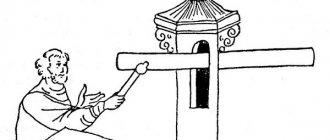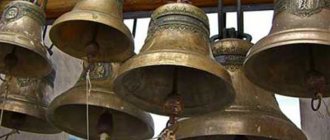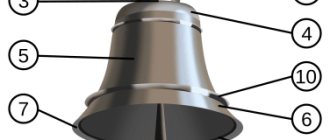A bell is a dome-shaped percussion instrument with a tongue inside. The sound from the bell comes when the tongue hits the walls of the instrument. There are also bells that do not have a tongue; they are struck from above with a special hammer or block. The material from which the instrument is made is mainly bronze, but in our time bells are often made from glass, silver and even cast iron.
The bell is an ancient musical instrument. The first bell appeared in China in the 23rd century BC. It was very small in size and riveted from iron. A little later, in China they decided to create an instrument that would contain several dozen bells of different sizes and diameters. This instrument was distinguished by its multifaceted sound and color.
In Europe, a bell-like instrument appeared several thousand years later than in China, and was called a carillon. People who lived in those days considered this instrument a symbol of paganism. Largely thanks to the legend about one ancient bell located in Germany, which was called “Pig Prey”. According to legend, a herd of pigs found this bell in a giant pile of dirt. People put it in order and hung it on the bell tower, but the bell began to exhibit a certain “pagan essence” and did not make any sounds until it was consecrated by local priests. Centuries passed and in the Orthodox churches of Europe, bells became a symbol of faith, famous quotes from the Holy Scriptures were engraved on them.
Bells in Rus'
In Rus', the appearance of the first bell occurred at the end of the 10th century, almost simultaneously with the adoption of Christianity. By the middle of the 15th century, people began to cast larger bells, as metal smelting factories appeared.
When the bells rang, people gathered for services, or veche. In Russia, this instrument was made of impressive size, with a very loud and very low sound, the ringing of such a bell was heard over very long distances (an example is the “Tsar Bell” made in 1654, which weighed 130 tons and its sound carried more than 7 miles ). At the beginning of the 17th century, there were up to 5-6 bells in Moscow bell towers, each weighing about 2 centners; only one bell ringer could handle it.
Russian bells were called “tongue” bells, since the sound came from them when the tongue was loosened. In European instruments, the sound came from loosening the bell itself, or when hitting it with a special hammer. This is a refutation of the fact that church bells came to Russia from Western countries. In addition, this method of striking made it possible to protect the bell from splitting, which allowed people to install bells of impressive size.
Bell ringing - what does it mean?
Bell ringing - what does it mean?
Church bell ringing is divided into two main types: 1. bell ringing and 2. ringing itself.
BLAGOVEST
Blagovest is the measured sound of one large bell. With this ringing, believers are called to the temple of God for Divine services. This ringing is called the gospel because it announces the good news about the beginning of the Divine service.
The gospel is performed as follows: first, three rare, slow, drawn-out strikes are made (until the sound of the bell stops), and then measured strikes follow. If the bell is very large or huge, then these measured blows are made by swinging the tongue at both edges of the bell. If the bell is relatively small, then in this case its tongue is pulled with a rope quite close to its edge, a board is placed on the rope and blows are made by pressing the foot.
Blagovest, in turn, is divided into two types: 1. Ordinary or frequent and is produced by the largest bell; and 2. Lenten or rare , produced by a smaller bell, on the weekdays of Great Lent.
If there are several large bells at the temple, and this happens at cathedrals, large monasteries, laurels, then the large bells, in accordance with their purpose, are distinguished into the following bells: 1) festive ; 2) Sunday ; 3) polyeleous ; 4) just everyday or everyday ; 5) fifth or small bell . Usually in parish churches there are no more than two or three large bells.
ACTUALLY RINGING
Actually, ringing is called ringing when all the bells or several bells are rung at once.
The ringing of all the bells differs in: 1. The ringing of all the bells is the ringing of all the bells, then a short break, and the second ringing of all the bells, again a short break, and the third time the ringing of all the bells, i.e. ringing of all the bells three times or ringing in three stages.
The trezvon expresses Christian joy and triumph.
In our time, trezvon began to be called not only ringing all the bells three times, but, in general, ringing all the bells.
2. Double ringing is ringing all the bells twice, in two steps.
3. Chime is ringing each bell in turn (one or several strikes on each bell), starting from the largest one to the smallest one, and repeating this many times.
4. Busting is a slow ringing of each bell once in turn, starting from the smallest to the largest, and after striking the large bell, striking all the bells together at once, and repeating this many times.
USE OF RINGING AND ITS SIGNIFICANCE
RINGING AT THE ALL-NIGHT VIgil
1. Before the beginning of the All-Night Vigil there is a bell ringing, which ends with the ringing of the bell.
2. At the beginning of the reading of the Six Psalms, two ringings are required. This double ringing announces the beginning of the 2nd part of the All-Night Vigil - Matins and expresses the joy of the Nativity of Christ - the incarnation of the Second Person of the Most Holy Trinity, our Lord Jesus Christ. The beginning of Matins, as we know, directly points to the Nativity of Christ and begins with the doxology of the angels who appeared to the Bethlehem shepherds: “Glory to God in the highest, and on earth peace, good will toward men.”
Popularly, the two-ringing at the all-night vigil is called the “second ringing” (the second ringing after the beginning of the all-night vigil).
3. During the singing of the polyeleos, just before the reading of the Gospel, a trezvon is placed, expressing the joy of the celebrated event. At the Sunday All-Night Vigil, the pealing of the trezvon expresses the joy and triumph of the Resurrection of Christ. (In some localities it is performed while singing: “Having seen the Resurrection of Christ”...) this ringing is usually called in the manuals “the ringing of the Gospel.”
People call the trezvon at the All-Night Vigil (“the ringing of the Gospel”) the “third bell.”
4. At the beginning of the singing of the song of the Mother of God: “My soul magnifies the Lord...” there is a short gospel, consisting of 9 strikes on a large bell (according to the custom of Kyiv and all of Little Russia).
5. On Great Holidays, at the end of the Vigil, there is a trezvon.
6. During the bishop’s Divine Service, after each All-Night Vigil, a trezvon is required to see off the bishop.
RINGING AT THE LITURGY
Before the beginning of the reading of the 3rd and 6th hours, the good news for the Liturgy is performed, and at the end of the 6th hour, just before the beginning of the Liturgy, the trezvon is rung.
If two Liturgies are served (early and late), then the bell for the early Liturgy is rarer and slower than for the late Liturgy, and is usually performed not on the largest bell.
During the bishop's Divine service, the good news for the Liturgy begins at the specified time. When a bishop approaches a church, a peal is rung. When the bishop enters the church, the trezvon stops and the bell ringing continues again until the bishop begins to vest. At the end of the 6th hour there is a ringing bell.
Then, during the Liturgy, the gospel is placed at the beginning of the “Eucharistic Canon,” the most important part of the Liturgy, to notify about the time of consecration and transubstantiation of the Holy Gifts.
At the prot. K. Nikolsky, in the book “Charter of Divine Services”, it is said that the gospel for “Worthy” begins with the words: “It is worthy and righteous to worship the Father and the Son and the Holy Spirit...”, and comes before singing: “It is worthy to eat, as truly, blessed Theotokos..." Exactly the same indication is found in the book: "New Tablet", Archbishop. Benjamin, ed. St. Petersburg. 1908 p. 213.
In practice, the bell to “Worthy” is shorter, consisting of 12 beats.
In the south of Russia, the gospel to “Worthy” is usually performed before the start of the “Eucharistic Canon”, during the singing of the Creed. (12 strikes, 1 strike for each member of the Creed).
The gospel to “Worthy” was introduced into the custom of Russian churches during the time of Moscow Patriarch Joachim (1690) in the likeness of Western churches, where they ring with the words: “Take, eat...”
After the end of the Liturgy, on all Great Holidays it is necessary to ring the bells (ring all the bells).
Also, after each Liturgy performed by the bishop, it is necessary to ring the bell to see off the bishop.
On the Feast of the Nativity of Christ, it is customary to ring the bells throughout the first day of the Feast, from Liturgy to Vespers.
On the Feast of Easter - the Resurrection of Christ:
The good news for Bright Matins begins before the Midnight Office and continues until the start of the procession, and from the beginning of the procession to the end of it, and even longer, there is a joyful solemn pealing.
For the Easter Liturgy - bell and trezvon.
And at the Easter Liturgy itself, during the reading of the Gospel, there is frequent chiming, 7 strikes on each bell (the number 7 expresses the fullness of the glory of God). This solemn chime signifies the preaching of the Gospel of Christ in all languages. This chime, after reading the Gospel, ends with a joyful, victorious peal.
Throughout Bright Easter Week, the trezvon is rung daily, from the end of the Liturgy to Vespers.
On all Sundays, from Easter to Ascension, after the end of the Liturgy, it is necessary to ring the trezvon.
On Temple Holidays:
At the end of the Liturgy, before the start of the prayer service, there is a short bell and trezvon, and at the end of the prayer service, a trezvon.
During all religious processions, a trezvon is required.
For the Royal Hours there is an ordinary bell ringing with a large bell, and for the Lenten Hours there is a Lenten bell ringing with a smaller bell. Both at the Royal Hours and at the Lenten Hours there is a ringing before each hour: before the 3rd hour the bell is struck three times, before the 6th - six times, before the 9th - nine times. Before fine and Compline - 12 times. But if there is a holiday during Lent, then the bell on the clock is not struck separately at each hour.
At Matins of Great Heel, which is served in the evening on Vel. Thursday and when the 12 Gospels of the Passion of the Lord are read, in addition to the usual blagovest and trezvon ringing at the beginning of Matins, the blagovest is performed for each Gospel: for the 1st Gospel - 1 strike of the large bell, for the 2nd Gospel - 2 strikes, for the 3rd Gospel – 3 hits, etc.
At the end of Matins, when believers carry the “Thursday fire” home, the trezvon is rung.
USING THE CHIME AND ITS IMPORTANCE
At the vespers of Great Heel, before the removal of the Shroud, during the singing: “For you who are clothed...”, a slow chime is supposed to ring once on each bell (from large to small), and according to the position of the Shroud in the middle of the temple, the peal is immediately rung.
At Matins of Great Saturday, starting with the singing of the “Great Doxology” and throughout the entire procession with the Shroud around the temple, a chime is required, the same as during the removal of the Shroud, i.e., a slow chime, 1 time in each bell from high to small. When they bring the Shroud into the temple and reach the Royal Doors with It, the ringing will immediately ring.
The slow ringing of each bell once, starting with the largest, most powerful sound, and gradually reaching the thinnest and highest sound of the small bell, symbolizes the “exhaustion” of our Lord Jesus Christ for the sake of our salvation, just as we sing, for example. , in the irmos of the 4th canto, 5th tone: “I understand Your Divine exhaustion... for the salvation of Your people...”.
According to the established centuries-old practice of the Russian Orthodox Church (in the central part of Russia), such a chime should be made only twice a year: on Vel. Friday and Vel. Saturday, the day of the Lord’s death on the cross and His free burial. Experienced bell ringers watch this especially strictly and in no way allow the mournful ringing of one relating to the Lord, our Savior, to be the same as the funeral ringing of ordinary, mortal and sinful people.
At Matins on the day of the Exaltation of the Cross of the Lord, on the Sunday of the Worship of the Cross and on August 1, before the removal of the cross from the altar during the singing of the “Great Doxology”, there is a chime, in which they slowly strike 3 times (in some areas 1 time) on each bell from largest to smallest. When the cross is brought to the middle of the temple and placed on the lectern, the peal will ring.
A similar chime, but only frequent, quick, and 7 times (or 3 times) for each bell, occurs before the small consecration of water. When the cross is immersed in water, it rings.
The same as before the blessing of water, there is a chime before ordination to the rank of Bishop. In general, frequent ringing of each bell several times is a solemn ringing. In some areas, such a chime is performed before the start of the Liturgy on church holidays and on other solemn occasions, for example, as mentioned above, when reading the Easter Gospel.
USING BURST AND ITS IMPORTANCE
Bust, otherwise a funeral or funeral bell, expresses sadness and grief for the deceased. It is performed, as already mentioned above, in the opposite order than the chime, that is, each bell is slowly struck once, from the smallest to the largest, and after that all bells are struck simultaneously. This mournful funeral procession necessarily ends with a short peal, expressing the joyful Christian faith in the resurrection of the deceased.
Due to the fact that some manuals on ringing indicate not to ring the bell during funeral services for the dead, and this does not correspond to church practice, we give some clarification on this matter.
The slow ringing of the bells, from the smallest to the largest, symbolizes the growing life of man on earth, from infancy to maturity and manhood, and the simultaneous striking of the bells means the end of earthly life by human death, in which everything that a person has acquired for this life is abandoned . As this is expressed in the songs during the funeral service: “All human vanity does not endure after death: wealth does not endure, nor glory descends: when death came, all this was consumed. (Or as another hymn says: “in one moment, and all this death is accepted”). Let us cry out to the immortal Christ: give rest to him who is departed from us, where everyone has a dwelling place for those who rejoice.”
The second part of the song directly points to the joy in the future life with Christ. It is then expressed, at the conclusion of the mournful enumeration, by a ringing sound.
In the magazine “Orthodox Rus'”, in the “Questions and Answers” section, Archbishop. Averky, regarding the customs during funeral services and memorial services, gave firmly grounded explanations, which should certainly also apply to the ringing: “According to our Orthodox custom, memorial services and funeral services are supposed to be performed in light vestments. The custom of performing these rites in black vestments came to us from the West and is completely unusual for the spirit of the saint. Orthodoxy, but nevertheless it has spread quite widely among us - so much so that it is not easy to eradicate it now... For a true Christian, death is a transition to a better life: joy, not sorrow, as this is beautifully expressed in the most touching third kneeling prayer, read on vespers on the day of Pentecost: “For there is no death, O Lord, for Thy servant, who proceeds to us from the body, and who comes to Thee our God, but repose from the sorrowful to the most wholesome and sweet, and to peace and joy” (see Triodion of Colors).
The trezvous, reminiscent of the resurrection, has a beneficial effect on the believing Christian soul, grieving over separation from the deceased, and gives it inner consolation. There is no reason to deprive a Christian of such consolation, especially since this trezvon has firmly entered the life of the Russian Orthodox people and is an expression of their faith.
Thus, when the deceased is carried to the church for the funeral service, a mournful search is performed, and when he is brought into the church, a trezvon is performed. After the funeral service, when the deceased is taken out of the church, a search is made again, which also ends with the ringing of the trezvon.
During the funeral service and burial of Priests, Hieromonks, Archimandrites and Bishops, a slightly different enumeration is performed. First, they strike the large bell 12 times, then the ringing follows, again the large bell is struck 12 times and the ringing again, etc. When the body is brought into the temple, a trezvon is performed, and after the prayer of permission is read, a trezvon is struck. When the body is taken out of the temple, there is again the indicated overkill, and when the body is placed in the grave, there is a ringing. In other places they call the usual funeral call.
The “Official Book” states that during the removal of Patriarch Joachim there was a bell sound, changing all the bells occasionally (Temporary Imperial Moscow General History and Ancient 1852 book 15, p. 22).
Recently we happened to find out that there was another type of busting - this is one blow on each bell, but starting from the big one to the small one, and then a simultaneous blow on all the bells. This was confirmed by the gramophone record: “Rostov Bells”, recorded in Rostov in 1963. In practice, we have never heard such a ringing; there are no instructions about it in ringing manuals. Therefore, we cannot indicate where and when it was used.
There is also the so-called red ringing of all the bells (“all the hard times”).
Red ringing occurs at cathedrals, monasteries, laurels, i.e. where there are a large number of bells, which include many large bells. The red ringing is performed by several bell ringers, five or more people.
The red ringing occurs on Great Holidays, during solemn and joyful events in the Church, as well as to honor the diocesan bishop.
In addition, we should also mention the “alarm” or “alarm” ringing, which has social and everyday significance.
An alarm or alarm ringing is the continuous, frequent striking of a large bell. The alarm or flash was rung during an alarm in the event of a fire, flood, rebellion, invasion of enemies or some other public disaster.
“Veche” bells were the name given to the bells with which residents of Novgorod and Pskov called people to a veche, that is, to a national assembly.
Victory over the enemy and the return of the regiments from the battlefield were heralded by the joyful, solemn ringing of all the bells.
In conclusion, let us recall that our Russian bell ringers have achieved high skill in bell ringing and have become famous throughout the world. Many tourists came from Europe, England and America to Moscow for the Easter holiday to listen to the Easter ringing.
On this “holiday holiday” in Moscow, in total, more than 5,000 bells rang from all churches. Anyone who heard the Moscow Easter ringing could never forget it. It was “the only symphony in the world,” as the writer I. Shmelev writes about it.
This powerful, solemn ringing shimmered throughout Moscow with the various melodies of each temple and ascended from earth to heaven, like a victorious hymn to the Risen Christ.
From the book “Fundamentals of the Worship of the Orthodox Church.”
Similar
Bells in modern Russia
Today, bells are used not only in bell towers, they are considered full-fledged instruments with a certain sound frequency. In music they are used in different sizes; the smaller the bell, the higher its sound. Composers use this instrument to emphasize melody. The ringing of small bells was loved by composers such as Handel and Bach in their works. Over time, the set of small bells was equipped with a special keyboard, making it easier to use. This instrument was used in the opera The Magic Flute.
Theology
Bell ringing is one of the most important elements of an Orthodox church.[1]Church bells ring:
- Call the faithful to serve
- Express the triumphant joy of the Christian church
- Announce important points during the service to both those in the church and those who cannot physically attend the church so that everyone can unite in prayer.
- Strengthen Christians in piety and faith with your sound, which, according to Orthodox Christians, is “mixed with divine grace to dispel and destroy the forces of cruelty and demonic suggestion”[2]
- Announce important events, such as the death of a church member; the arrival of an important person such as a bishop or civil ruler; an emergency such as fire or flood; or victory in battle (as dramatically recreated in the victorious conclusion of the 1812 Overture).
The use of bells is not only practical, but is also considered spiritual. Bells are sometimes called "singing icons" because they establish the acoustic space of an Orthodox church in the same way that painted icons and hymnography define its visual and mental space respectively. Icons are considered “Scripture in image,” just as bells are considered “Scripture in sound.”
There are several services that highlight the importance of bells in the Russian Orthodox Church: Blessing then Foundation of the new Bell Tower
,
Blessing of the new bell tower
(after construction is completed),
Blessing, naming and Cleansing bell
. There is also a bell ringer blessing service.
The bells are blessed in a ritual containing many elements of the Rite of Baptism. The new bell is endowed with holy water and centered, both outside and inside, and the priest lays his hands on the bell to bless it. During the ritual, the bell is "named" (that is, consecrated in honor of the saint, whose badge was often poured into the side of the bell when it was Cast at the Foundry - but although the bell may be called the "Gabriel" bell, it will never be called the "bell" St. Gabriel" because the bell is not holy).
The bell is also anointed with myrrh, like an Orthodox Christian in anointing. The theological understanding of bells as "weapons" in spiritual warfare, and their role in Christian life is emphasized during the ritual scripture lesson from Numbers 10:1–10:
“And the Lord spoke to Moses, saying: Make for yourself two silver trumpets... And they will be for you to call the assembly... When you raise the alarm... And if you go out to war... And in the days of your rejoicing...”
The use of bells symbolizes the proclamation of the Gospel. Sometimes Orthodox churches and monasteries combine the use of bells with the striking of a wooden or metal semantron, where the semantron is sounded first and then the bells are rung. The quieter and simpler sound of the semantron is said to symbolize the Old Testament prophets, as it is a symbol of only a future event, while the ringing of bells travels far into the air, symbolizing the gospel of the Gospel throughout the world.[2]
Gallery
- Three 17th century Russian Orthodox Church bells at Arundel Castle, West Sussex United Kingdom. These bells were taken as trophies from Sevastopol at the end of the Crimean War in 1856.
- Three bells of the Russian Orthodox Church of the 17th century at Arundel Castle
- Three bells of the Russian Orthodox Church of the 17th century at Arundel Castle
- Three bells of the Russian Orthodox Church of the 17th century at Arundel Castle
Recommendations
- ^ a b
Slobodskoy, Archpriest Seraphim (1996), "Bells and Russian Orthodox Bells",
Law of God
, Jordanville, New York: Holy Trinity Monastery, pp. 623–635, ISBN 0-88465-044-8 - ^ a b c d Typikon for church bell ringing
(PDF), Moscow: Editorial office of the Russian Orthodox Church, 2002., received 2007-12-29 (English translation 2003, Blagovest Bells, San Anselmo, Cal.) - Thurston, Herbert (1907), "Bells", Catholic Encyclopedia
,
II
, New York: Robert Appleton Company, retrieved 2007-12-29 - "Russia. TV channel "Culture". A school of bell ringers is opening in Moscow.” Tvkultura.ru. 2008-10-15. Retrieved 2014-06-15.










